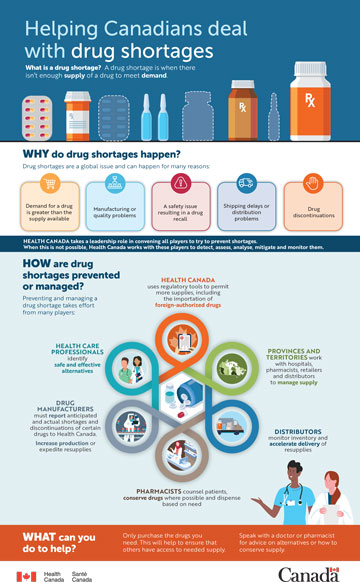August 1, 2023
It’s a situation no one wants to face. You need a medication or health product, but you can’t find it anywhere. The reason? A shortage.
Many of us have become all too familiar with drug shortages, which have been increasing in the last few years. Global supply constraints, manufacturing issues, difficulties in accessing raw materials and the COVID-19 pandemic are some of the key reasons behind this increase.
Fortunately, Health Canada experts have been working hard to address shortages. Stephanie Di Trapani, Director of Health Canada’s Drug Shortages Division, has made it her personal mission to detect, assess, analyse, mitigate, and monitor shortages. And she’s been doing exactly that in various roles for more than 10 years.
Building a foundation
In 2012, a critical national shortage of painkillers, anesthetics, antibiotics, and hospital injectable products had severe consequences. The impact was widespread with many people not being able to get the medications they needed, and some surgeries being postponed or even cancelled.
“Up until this point, Canada hadn’t truly faced a critical national shortage of that scope. We were in uncharted territory. Back then, Health Canada’s focus was mostly on ensuring drugs were safe, effective and of good quality. This shortage showed us that we needed to be more proactive and increase coordination between all stakeholders,” explains Ms. Di Trapani.
In response to that shortage, Health Canada helped create the Multi-Stakeholder Steering Committee on Drug Shortages (MSSC) in 2012. This committee, co-chaired by Health Canada, brings together federal, provincial, and territorial governments, and health professional, patient and industry associations. It was formed to improve information sharing and to identify actions to manage and mitigate drug shortages in Canada.
Increasing transparency
The creation of the committee was helpful in improving responses to shortages. That being said, Ms. Di Trapani and her team still needed more information from manufacturers to prevent and mitigate shortages.
“Getting the facts early is key. The sooner manufacturers share the information we need, the greater the impact we can have to reduce a shortage,” says Ms. Di Trapani.
Recognizing this information gap, Ms. Trapani and her team worked on new regulations requiring that manufacturers report existing and anticipated shortages as well as discontinuations of certain prescription medications. In fact, Canada was one of the first countries to implement shortage reporting regulations.
Thanks to these regulations, Health Canada has improved its capacity to:
- assess the supply and demand situation of a drug;
- identify options to mitigate the impact of drug shortages, such as permitting the importation of foreign-authorized supply, extending the expiry date of products, and where possible assisting with the acceleration of deliveries of resupplies;
- ensure there is timely and effective communication between all potentially impacted groups; and,
- work with stakeholders on strategies to prevent shortages and strengthen the supply chain.
If you're looking about information related to shortages of certain drugs, click here
Constantly improving
Unfortunately, not all shortages can be avoided, mitigated, or solved as quickly as we would like due to their complexity and factors beyond our control. Last fall, Canada experienced a shortage of children’s analgesics (acetaminophen and ibuprofen) and antibiotics. Unprecedented demand caused a shortage that lasted upwards of eight months.
Ms. Di Trapani and her team worked around the clock to find solutions. These included working with manufacturers to secure supplies from other countries, contacting pharmacists to help manage supplies and working with health professionals to provide information and advice to parents and caregivers who were affected by this shortage.
“It was quite a challenge. But the systems we put in place over the past decade helped us find innovative ways to manage this shortage and make sure parents and caregivers got the medications they needed. We’ve already started making good use of the lessons from this shortage for the upcoming cold and flu season,” says Ms. Di Trapani.
While Health Canada experts and health stakeholders do everything they can to help manage these shortages, they can’t do it alone. They need your assistance. To learn more about how drug shortages are managed and how you can help by checking out the infographic below.
-
Text version - Infographic: Helping Canadians deal with drug shortages
Helping Canadians deal with drug shortages
What is a drug shortage?
A drug shortage is when there isn't enough supply of a drug to meet demand.
Why do drug shortages happen?
Drug shortages are a global issue and can happen for many reasons:
- Demand for a drug is greater than the supply available
- Manufacturing or quality problems
- A safety issue resulting in a drug recall
- Shipping delays or distribution problems
- Drug discontinuations
Health Canada takes a leadership role in convening all players to try to prevent shortages.
When this is not possible, Health Canada works with these players to detect, assess, analyse, mitigate and monitor them.
How are drug shortages prevented or managed?
Preventing and managing a drug shortage takes effort from many players:
- Health Canada
- uses regulatory tools to permit more supplies, including the importation of foreign-authorized drugs
- Health care professionals
- identify safe and effective alternatives
- Provinces and territories
- work with hospitals, pharmacists, retailers and distributors to manage supply
- Drug manufacturers
- must report anticipated and actual shortages and discontinuations of certain drugs to Health Canada
- increase production or expedite resupplies
- Distributors
- monitor inventory and accelerate delivery of resupplies
- Pharmacists
- counsel patients, conserve drugs where possible and dispense based on need
What can you do to help?
Only purchase the drugs you need. This will help to ensure that others have access to needed supply.
Speak with a doctor or pharmacist for advice on alternatives or how to conserve supply.
Download the infographic in PDF format here.

